Trump could be right about the strong US dollar

A strong dollar is starting to cause problems to the US economy.
Could it be that US President Donald Trump has accidentally told the truth?
In between tweeting conspiracy theories linking Bill Clinton with a paedophile billionaire’s suicide in jail and successfully campaigning to get the Hollywood movie release of The Hunt canned, Trump has continued to complain that the US dollar is too high.
And it seems that he has a point – one that we are acutely aware of here in Australia as our dollar continues to plunge well into the US67c range.
US dollar strength has been extraordinary
On several measures the US dollar has been trouncing currencies around the world – rising an amazing 32% since 2011 and becoming the strongest currency of any major developed country.
While a lot of US dollar strength is due to its continuing robust economic performance compared to other countries and to the status of the US dollar as a de-facto reserve currency that is used to price so many commodities, Trump is right to complain that the high dollar is restricting the performance of the US economy.

The US dollar continues to gain on the Aussie.
The strong dollar helps the US to attract lots of consumer imports and to run trade deficits with many countries and it also makes US exports more expensive and difficult to sell.
Suppressing profits around the world
The strong dollar also reduces the profits of many US multinationals as they restate their global earnings back to their home currency and it also raises the cost of servicing US dollar debts.
That really impacts the many non-US companies that have US dollar debts because they have to pay back more money in their local currency to make their repayments, effectively suppressing profits in countries other than the US.
Global monetary policy tightened by strong dollar
That is a serious matter given that the Bank for International Settlements estimates that US dollar-denominated liabilities to non-bank borrowers outside the US reached US$11.8 trillion this year.
Even now that the US Federal Reserve has started to cut US interest rates, that has failed to dent the US dollar because global interest rates were already heading downwards.
Australia is a great example, with our official interest rates falling to a record low of 1% well before the US Fed decided to cut by 25 basis points to a range between 2% and 2.25%.
US Fed has been slow to cut
The US has been slower to resume cutting rates – indeed Chairman Jerome Powell indicated this cut is a pre-emptive insurance policy rather than the start of a series of cuts – so the US dollar looks set to remain strong against most currencies as long as the country’s growth remains intact and it retains a positive interest rate differential with many countries.
US growth and unemployment will be the measures to watch for because if other countries have got the jump on the US by cutting rates earlier, you would expect to see their growth rates pick up as the stimulus flows through compared to a later and lower amount of stimulus in the US.
Currencies are particularly sensitive to growth rates and should the US finally lose its edge over large slabs of the world such as Japan and Europe, that could sow the first seeds for a weaker US currency – not to mention increasing the much talked about chances of a recession.
